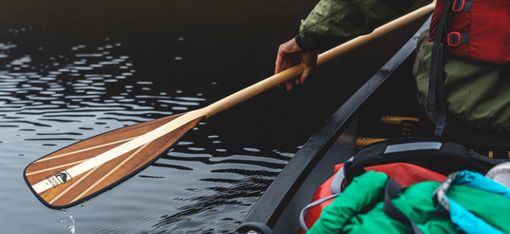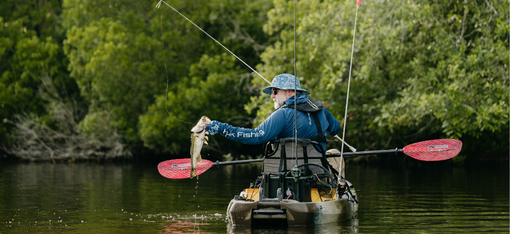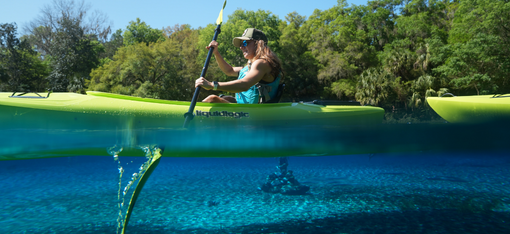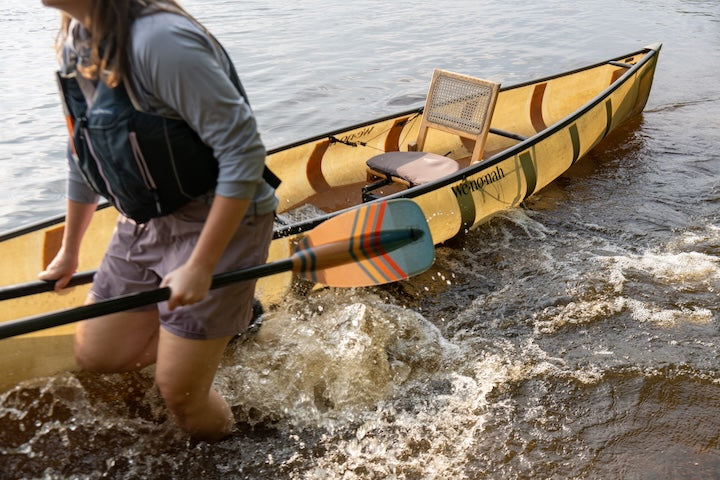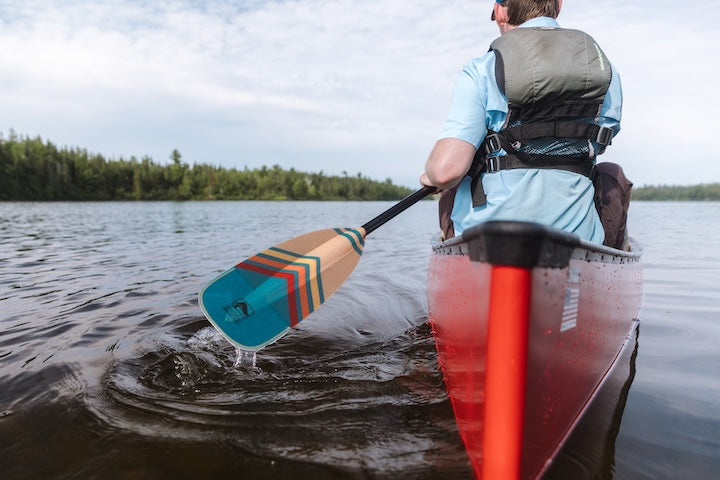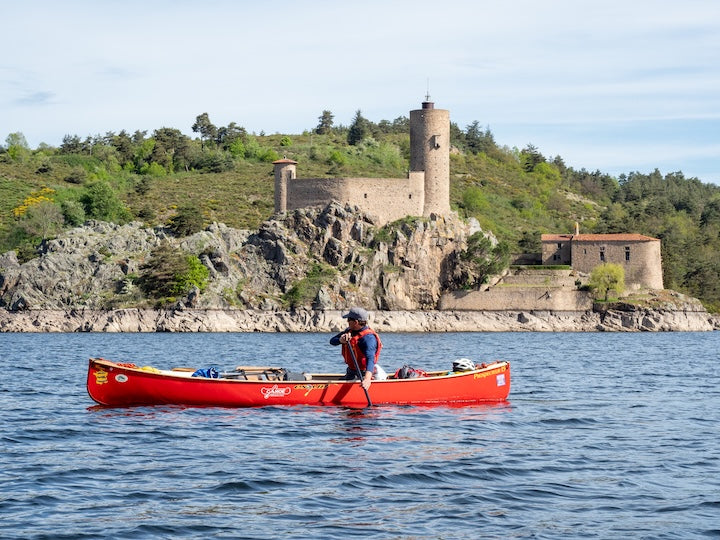Wilderness Canoe Tripping: Minnesota vs. Maine
9-minute read
While canoeing in Minnesota and Maine are very similar in many ways—both have plenty of forests, lakes and rivers—the wilderness canoe cultures in these two US states are quite distinct from one another.
Scott Oeth, a Minnesotan who’s canoed extensively in both states, helps us see and appreciate these similarities and especially the differences.

Scott Oeth canoe poles down Maine’s Machias River
Scott is a part-time Minnesota canoe guide and instructor, based out of his company, Bull Moose Patrol. He loves canoeing all over the country, and has developed a special appreciation for Maine.
“Over the past several years, I've been taking canoe trips in Maine. In part, for the great wilderness canoe camping options, but also because the rich canoeing history and culture in Maine rivals my own home state of Minnesota!” Scott says on his website.
We recently had a chance to glean some insights from him on the similarities and differences of wilderness canoeing between these two states. He’s gotten to know a lot of the large canoe community there, and sees the two as sister states, Maine and Minnesota:
Minnesota Wilderness Canoeing: BWCAW
Minnesota’s premier wilderness canoe destination is the Boundary Waters Canoe Area Wilderness (BWCAW), a million acres located in the northeast region of the state. It’s primarily lake country (1,100 of them, plus rivers and streams) with 1,500 miles of trip route options, and portages connecting the lakes to each other. Almost 2,200 developed campsites dot the area.
The BWCAW averages 250,000 visitors each year, making it one of the most-visited wilderness areas in the US.

Minnesota or Maine? This scene resembles both—but it happens to be Maine’s Allagash Wilderness Waterway
Maine Wilderness Canoeing: Most of the State
Maine is roughly a third of the size of Minnesota in square miles, with 80% covered by forest. Its population is currently 1.37 million people, with the lowest population density of the states east of the Mississippi River.
The state hosts thousands of lakes as well as many major rivers like the St. John, the Penobscot and the Allagash. Much of the wilderness canoeing is in North Maine Woods, a 3.5-million-acre region that covers a large section in the northwestern part. This undeveloped wilderness area sees about 100,000 visitors a year, including canoeists that paddle its waterways.
So, the first difference we see between the wilderness canoe areas of these two states is the number of visitors they get annually. Here are some other similarities and differences:
Topography
At first glance, Minnesota’s BWCAW and Maine share very similar topography. They’re both covered with boreal forest, and host thousands of lakes. They both have abundant wildlife and offer true wilderness experiences. They both sit at about the same latitude line.

Minnesota or Maine? This one is Minnesota (photo courtesy of Sharon Brodin)
Maine, though, has a more varied topography, from sea level at its coasts to 5,269-foot Mount Katahdin, its tallest peak. This part of Minnesota, while relatively mountainous for the Midwest, ranges from 600 feet at Lake Superior to 2,301-foot Eagle Mountain, Minnesota’s tallest peak.
Maine has some nice lake chains, but “more of their canoe culture is centered on these great long rivers they have,” said Scott.
Wildlife
Both states are home to moose, deer and black bear. Minnesota has wolves, while Maine doesn’t.
A couple interesting differences:
- Maine’s moose population dwarfs Minnesota’s by more than twenty times.
- While canoeists in the BWCAW always think about bears and practice bear safety with their food and themselves, Scott noted that the mindset is very different in Maine: “Mainers don’t give two figs about them!” He guesses it’s the combination of more square miles of wilderness and fewer people, so encounters with bears are rare. “In the BWCAW, it’s easier for bears to become conditioned to the campsite locations.”
Canoes and Canoeing Style
Scott noted that BWCAW canoeists tend to focus on getting their canoe from Point A to Point B, take the portage with as few trips as possible, then continue on in the next lake.
They prefer light, sleek and fast canoes, with canoe makers adapting their designs to accommodate them. Outfitters for the BWCAW have largely switched from classic aluminum canoes to lighter Kevlar models.

Canoe poling remains popular in Maine’s canoe culture
In Maine, with river canoeing being dominant, “poling” is still popular. That means it’s not uncommon to see canoeists standing up while moving down (or up) the rivers, using long paddles as poles on the river bed to help maneuver the canoe exactly where they want it. The classic, symmetrical canoe design with its flatter hull and rockers on each end suit this style best.
Because portages aren’t as common and are typically shorter—to get around whitewater or falls—Mainers aren’t concerned about the weight of their canoes as much as how they handle on the water. Therefore, their canoes are heavier and able to withstand impact on river rocks better.
Another difference, Scott said, is that “Solo, in Maine, means one person in a full-sized canoe, rather than the Minnesota mindset of requiring a specific downsized solo canoe.”
Differences in Paddling
In the BWCAW, canoeists use a variety of canoe paddle shapes including traditional straight shaft, bent shaft, Beavertail blade shape and what most consider a standard canoe paddle blade.

A “Maine guide paddle” can be used standing or seated
Because of the popularity of poling in Maine, there’s a type of paddle known as a Maine guide paddle that’s suited for both poling and paddling. They can be more than six feet long. They have an extra-long grip so the paddler can adjust the paddle’s length as the grip hand can be placed at either the top or along the side.
“One of the things that drew me into going to Maine in the first place was poling. I’d seen those old images of people standing up and using a pole. It seemed almost mythical, but there’s a handful of people that still keep that tradition alive,” said Scott.
“I wanted to learn how to pole a canoe, so I went to a guide school [in Maine] that’s focused on poling. I found that it’s so much fun, it’s very practical, it’s efficient, it gives you a very different view. You’re in complete control of your descent going down rapids. If you’re good you can turn and work your way up the rapids.”
Portaging and Gear
Things continue to get different…
BWCAW canoeists pack their gear into as few large packs as possible in order to be able to make as few trips as possible over each portage. Portage packs are soft-sided, made of waxed canvas or tough polyester.
“Canoeists are very dialed in for packing and portaging in the Boundary Waters,” said Scott. “It’s all very efficient.” They want their canoes light so they can haul them along with a pack on the portages. “Most have the single-trip portage as their goal.”
In Maine, on the other hand, traditional gear and food containers like pack baskets and wannigans (more on those below) are still very common.
Pack baskets date back several hundred years to Native American and early explorer use. “Mainers tend to use lots of small packs. They’re not as worried about efficiency,” Scott said.

Scott uses a pack basket while carrying his young son
Food and Cooking
Food and cooking is another subject with wide differences between the two canoe destinations.
Because of the emphasis on portaging and lightening the loads, food and cooking in the BWCAW has trended towards the backpacking style of bringing dehydrated foods that are ultra-light and can be cooked with just boiling water.
Food is packed in either a dedicated food pack or in barrel(s). Highly-packable and light camp stoves are common, especially as available firewood gets scarcer due to more people using the most popular campsites.
“Maine guides take a lot of pride in their cooking,” said Scott. “It’s about hospitality, fresh food. They use hard-sided cooler packs and tumplines to portage. Some use insulated wannagins for their food—traditional wooden boxes dating back to the Voyageur days. Campfire cooking is a highly-regarded skill, including baking.”

An example of Maine canoe trip cooking—laid out on several wannagins that have been in use for 50+ years
Trip Guiding
Speaking of guides, here is another difference:
In Minnesota’s Boundary Waters, most of the canoe guides are college students and other young adults trained as seasonal workers. The groups they guide are generally younger kids through scouting and camp programs. Experienced canoeists don’t hire guides, and, in fact, most would scoff at the idea of needing one.
In Maine, though, guiding is a revered part of the canoeing culture. “Many of the guides are older and have grown up with their guiding parents and grandparents as a cottage industry,” Scott said. “Canoeists’ competence has nothing to do with it—it’s more about the overall experience.” (Indicated by the Food and Cooking section above!)
To be a licensed guide in Maine means something. They have to pass a rigorous test in order to represent the state of Maine.
In Summary
As Scott points out, neither of these canoe cultures is better than the other, they’re just different. He does love the poling seen out in Maine, though: “I’ve been on a one-man mission to bring poling back to the Midwest. People used to pole around here, starting with the Native Americans and Voyageurs.”

Scott Oeth, avid canoeist and owner of Bull Moose Patrol
Scott is a Registered Maine Guide, a Minnesota Master Naturalist and a Wilderness First Responder. He frequently presents workshops at outdoor expos like Canoecopia in Wisconsin and Midwest Mountaineering’s Outdoor Expo in Minneapolis.
You can connect with Scott through his website, Bull Moose Patrol. You’ll also find him on Facebook and Instagram.
All photos courtesy of Scott Oeth and Bull Moose Patrol except where noted.
Do you have paddle questions our friendly Customer Service Team can help you with today? Contact them: 715-755-3405 • bbinfo@bendingbranches.com
More for you...




